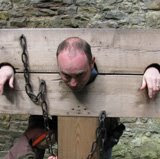Zeppelins were terrifying new technology and were responsible (amongst other things) for many civilian deaths in WW1. They must also have been quite terrifying to be on, being so slow, visible and ludicrously flammable. I was reminded of all of this, and particularly this letter, today whilst talking to some of the people I met at Who Do You Think You Are Live. A gentleman from the RAF Museum told me how it had taken until the middle of the war to realise that, by combining some technologies that had been around for a decade or more, it was possible to set light to enemy balloons (not actually in the way that happened in this account, though, with an incendiary bomb dropped from an aircraft above).
And it all brought back my very first week at IWM, 4 years back, when we new recruits did an object handling session. The mystery object that my group was given turned out to be a felt overboot, worn outside the leather boots of a zeppelin airman (it gets damn cold up there). It was recovered from a Suffolk field after its owner jumped to escape a conflagration of the sort that Patrick Blundstone described. The felt was still blackened from the burning hydrogen.
This is not the boot, but it's not dissimilar:

Boot (felt), Imperial German © IWM (UNI 12723)
As always, remember that I'm not a historian and many or all of the statements in this post may be incorrect!











